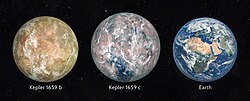Kepler-1649b
| Discovery | |
|---|---|
| Discovered by | Kepler spacecraft |
| Discovery date | 2017[1] |
| Transit | |
| Designations | |
| KOI-3138.01 | |
| Orbital characteristics | |
| 0.0514 ± 0.0028 AU | |
| 8.689099 ± 0.000025 d | |
| Inclination | 89.150 |
| Star | Kepler-1649 |
| Physical characteristics | |
| 1.017 ± 0.051 R🜨 | |
| Mass | 1.03 ME |
Kepler-1649b is an exoplanet orbiting the red dwarf star Kepler-1649, discovered in 2017.[2] It is similar to Venus,[3][4] but in the past it was thought to be a candate for habitability.[5]
Host star
Kepler-1649 is a type-M red dwarf star estimated to be roughly ¼ the radius of the Sun [6] with only two confirmed planets in its orbit, the other being Kepler-1649c.[7] Kepler-1649c is similar to Earth from our own solar system in two ways: both Kepler-1649c and Earth have orbits roughly twice the radius of the previous known planets (Kepler-1649b and Venus respectively), and they are of similar size.
Orbit
Kepler-1649b takes only 8.6 Earth days to orbit Kepler-1649.

References
- ^ Angelo, Isabel; Rowe, Jason F.; Howell, Steve B.; Quintana, Elisa V.; Still, Martin; Mann, Andrew W.; Burningham, Ben; Barclay, Thomas; Ciardi, David R.; Huber, Daniel; Kane, Stephen R. (2017-04-01). "Kepler-1649b: An Exo-Venus in the Solar Neighborhood". The Astronomical Journal. 153 (4): 162. arXiv:1704.03136. Bibcode:2017AJ....153..162A. doi:10.3847/1538-3881/aa615f. ISSN 0004-6256.
- ^ "Exoplanet-catalog". Exoplanet Exploration: Planets Beyond our Solar System. 2 May 2017. Retrieved 2020-04-16.
- ^ "Possible Venus Twin Discovered Around Dim Star". SETI Institute. Retrieved 2025-05-06.
- ^ Angelo, Isabel; Rowe, Jason F.; Howell, Steve B. (November 2015). "An Exo-Venus Around a Cool, Nearby Star". AAS/Division for Planetary Sciences Meeting Abstracts #47. 47: 417.03. Bibcode:2015DPS....4741703A.
- ^ Kane, Stephen R.; Hill, Michelle L.; Kasting, James F.; Kopparapu, Ravi Kumar; Quintana, Elisa V.; Barclay, Thomas; Batalha, Natalie M.; Borucki, William J.; Ciardi, David R.; Haghighipour, Nader; Hinkel, Natalie R.; Kaltenegger, Lisa; Selsis, Franck; Torres, Guillermo (2016-10-10). "A Catalog of Kepler Habitable Zone Exoplanet Candidates". The Astrophysical Journal. 830 (1): 1. arXiv:1608.00620. Bibcode:2016ApJ...830....1K. doi:10.3847/0004-637X/830/1/1. ISSN 0004-637X.
- ^ McDonald, Rebecca (April 15, 2020). "Dedicated Team of Scientists Discover Habitable-Zone Earth-Size Planet in Kepler Data". Seti Institute. Retrieved April 17, 2020.
- ^ "Exoplanet-catalog". Exoplanet Exploration: Planets Beyond our Solar System. 2 May 2017. Retrieved 2020-04-16.
